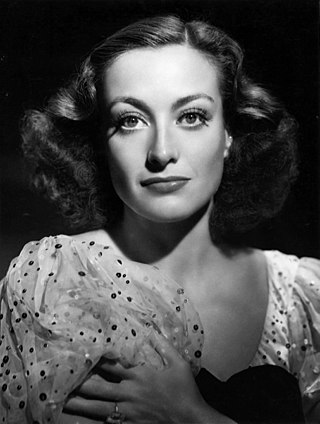
Joan Crawford was an American actress. She started her career as a dancer in traveling theatrical companies before debuting on Broadway. Crawford was signed to a motion picture contract by Metro-Goldwyn-Mayer in 1925. Initially frustrated by the size and quality of her parts, Crawford launched a publicity campaign and built an image as a nationally known flapper by the end of the 1920s. By the 1930s, Crawford's fame rivaled MGM colleagues Norma Shearer and Greta Garbo. Crawford often played hardworking young women who find romance and financial success. These "rags-to-riches" stories were well received by Depression-era audiences and were popular with women. Crawford became one of Hollywood's most prominent movie stars and one of the highest paid women in the United States, but her films began losing money. By the end of the 1930s, she was labeled "box office poison".

Ruth Elizabeth "Bette" Davis was an American actress with a career spanning more than 50 years and 100 acting credits. She was noted for playing unsympathetic, sardonic characters, and was famous for her performances in a range of film genres, from contemporary crime melodramas to historical films, suspense horror, and occasional comedies, although her greater successes were in romantic dramas. A recipient of two Academy Awards, she was the first thespian to accrue ten nominations.

What Ever Happened to Baby Jane? is an American psychological horror novel by Henry Farrell published in 1960 by Rinehart & Company. The novel has earned a cult following, and has been adapted for the screen twice, in 1962 and 1991.

Dangerous is a 1935 American drama film directed by Alfred E. Green and starring Bette Davis in her first Oscar-winning role. The screenplay by Laird Doyle is based on his story Hard Luck Dame.

The Star is a 1952 American drama film directed by Stuart Heisler and starring Bette Davis, Sterling Hayden and Natalie Wood. The plot tells the story of an aging, washed-up actress who is desperate to restart her career. Even though the film was a critical and commercial failure, Bette Davis received an Academy Award nomination for Best Actress.
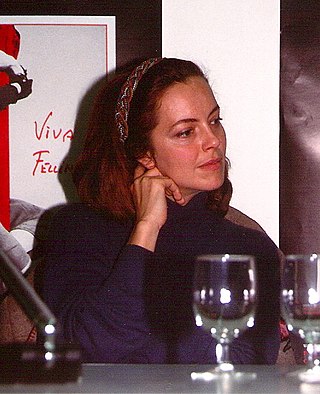
Greta Scacchi, OMRI is an Italian-Australian actress. She is best known for her roles in the films White Mischief (1987), Presumed Innocent (1990), The Player (1992), Emma (1996), and Looking for Alibrandi (2000).

Hush...Hush, Sweet Charlotte is a 1964 American psychological thriller film directed and produced by Robert Aldrich, and starring Bette Davis, Olivia de Havilland, Joseph Cotten, Agnes Moorehead and Mary Astor in her final film role. It follows a middle-aged Southern woman, suspected in the unsolved murder of her lover from decades before, who is plagued by bizarre occurrences after summoning her cousin to help challenge the local government's impending demolition of her home. The screenplay was adapted by Henry Farrell and Lukas Heller, from Farrell's unpublished short story "What Ever Happened to Cousin Charlotte?"
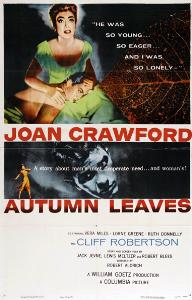
Autumn Leaves is a 1956 American psychological drama film directed by Robert Aldrich and starring Joan Crawford in an older woman/younger man tale of mental illness. The film was distributed by Columbia Pictures. The screenplay was written by Jean Rouverol and Hugo Butler, though it was credited to Jack Jevne, since Rouverol and Butler were blacklisted at the time of the film's release.
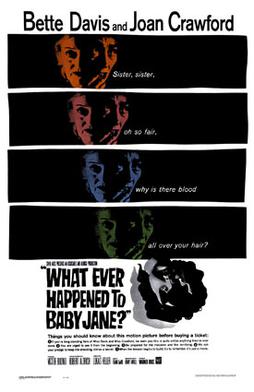
What Ever Happened to Baby Jane? is a 1962 American psychological horror thriller film directed and produced by Robert Aldrich, from a screenplay by Lukas Heller, based on the 1960 novel of the same name by Henry Farrell. The film stars Bette Davis and Joan Crawford, and features the major film debut of Victor Buono. It follows an aging former child star tormenting her paraplegic sister, a former movie star, in an old Hollywood mansion.
What Ever Happened to... is a 1991 American made-for-television thriller film directed by David Greene and adapted for the small screen by Brian Taggert. It is based on the 1960 novel What Ever Happened to Baby Jane? by Henry Farrell and the 1962 theatrical film of the same name. It stars real-life sisters Lynn Redgrave as Baby Jane Hudson and Vanessa Redgrave as Blanche Hudson, in the roles previously played by Bette Davis and Joan Crawford in the 1962 adaptation.

John Elmer Carson, known as Jack Carson, was a Canadian-born American film actor. Carson often played the role of comedic friend in films of the 1940s and 1950s, including The Strawberry Blonde (1941) with James Cagney and Arsenic and Old Lace (1944) with Cary Grant. He appeared in such dramas as Mildred Pierce (1945), A Star is Born (1954), and Cat on a Hot Tin Roof (1958). He worked for RKO and MGM, but most of his notable work was for Warner Bros.

Brian James Davis, better known as David Brian, was an American actor. He is best known for his role in Intruder in the Dust (1949), for which he received critical acclaim and a Golden Globe nomination. Brian's other notable film roles were in The Damned Don't Cry (1950), This Woman Is Dangerous (1952), Springfield Rifle (1952), Dawn at Socorro (1954), and The High and the Mighty (1954).

Sadie McKee is a 1934 American pre-Code, romantic-drama film directed by Clarence Brown, starring Joan Crawford, and featuring Gene Raymond, Franchot Tone, Edward Arnold, and Esther Ralston. The film is based on the 1933 short story "Pretty Sadie McKee", by Viña Delmar. Crawford plays the title character, from young working girl through poverty, a marriage into enormous wealth and finally a (seemingly) settled life on her own terms.
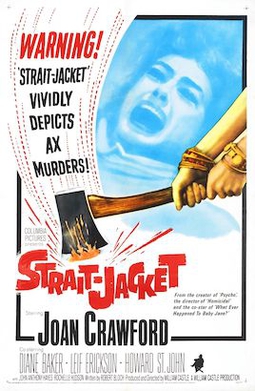
Strait-Jacket is a 1964 American psychological thriller film directed and produced by William Castle, written by Robert Bloch and starring Joan Crawford. Its plot follows a woman who, having murdered her husband and his lover decades prior, is suspected of a series of axe murders following her release from a psychiatric hospital.
The 35th Academy Awards, honoring the best in film for 1962, were held on April 8, 1963, at the Santa Monica Civic Auditorium in Santa Monica, California, hosted by Frank Sinatra.

Ruby Romaine is a fictional character portrayed by Tracey Ullman on her show Tracey Takes On... The character became so popular that HBO greenlit a pilot for a potential Ruby Romaine spin-off series resulting in the one-off television special, Tracey Ullman in the Trailer Tales in 2003. Ruby is a self-proclaimed "star maker".
Ernest Jacob Haller, sometimes known as Ernie J. Haller, was an American cinematographer.
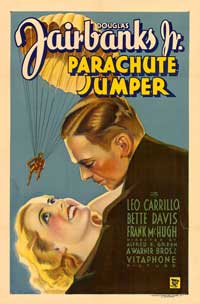
Parachute Jumper is a 1933 American pre-Code black-and-white comedy drama film directed by Alfred E. Green. Based on a story by Rian James titled "Some Call It Love", it stars Douglas Fairbanks Jr., Bette Davis and Frank McHugh.

Maidie Ruth Norman was an American radio, stage, film, and television actress as well as an instructor in African-American literature and theater.

Feud is an American docudrama television series created by Ryan Murphy, Jaffe Cohen, and Michael Zam, which premiered on FX on March 5, 2017. Conceived as an anthology series, Feud's first season, Bette and Joan, chronicles the well-documented rivalry between Hollywood actresses Joan Crawford and Bette Davis during and after the production of their psychological horror thriller film What Ever Happened to Baby Jane? (1962). Jessica Lange and Susan Sarandon star as Crawford and Davis, respectively. Judy Davis, Jackie Hoffman, Alfred Molina, Stanley Tucci, and Alison Wright feature in supporting roles. Academy Award–winning actresses Catherine Zeta-Jones and Kathy Bates also appear.

















